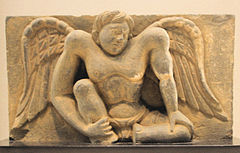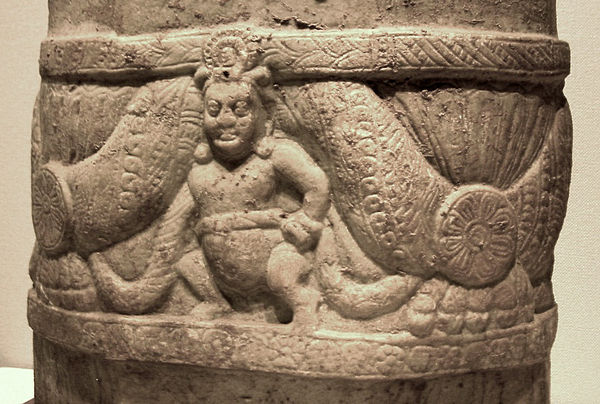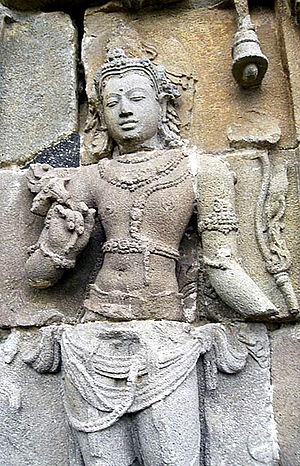The 2009, American intelligence agencies gave the EII information that Ukrainian mafiosi were held ready for sale on the 30 Greek and Roman Antiquities. The EII immediately informed the head of the Greek police., the Culture Ministry and the competent Minister Antonis Samaras. The case took to handle on his secrets and his advisor, Chrysanthos Lazaridis, in collaboration with the archaeologist ' Katerina ', which was then appointed in the Office of a Minister and belonged to the archaeologists of the Ministry.
«Lazaridis with "Katerina" were installed in the attic of the building of Bouboulinas, isolated from other employees and nobody knew what exactly dealing. Archaeologists have labeled the attic "giafka", as it was away from prying eyes and there was great secrecy», said archaeologist with a long tenure at the Ministry's main building.

The environment of Samara, with the agreement of the Secretary-General Thodoris Dravilas, then decided to keep watertight case and to not update (as is the usual procedure) the Department of Archaiokapilias security Prosecution that had gained in recent years important experience from international cooperation and had made very significant successes in prosecuting cross-border crime of archaiokapilias, as-among many others- the case of the Getty Museum, the case "Shelby White» and of course the famous case of Shinoussa (that for unknown reasons never reached in the audience). The "giafka" chose to work only with the EII, as this would facilitate the tightness of the case.
Political developments and early elections are not allowed to proceed with the investigation. The Karamanlis government resigned, the elections in October 2009 highlighted winner George Papandreou and Culture Minister Pavlos Geroulanos took.
With intervention of Antonis Samaras, who relied on the case of Ukraine, remained in the "Bouboulina Katerina», as operator of the dossier, which was appointed the new Minister and consultant. At The Same Time, returned as General Secretary of the Ministry of the Lina Mendoni, a close collaborator of Evangelos Venizelos who had served on the ypoyrgias in the same location (1999-2004).
The 2010, the case of Ukraine was itself revived. The "Katerina" in cooperation with "Jacob", an informant from Thessaloniki, and with the assistance of Katehaki, plowed North Greece in search of the Tomb from which they could derive the Greek Antiquities arrived in the hands of the Ukrainian mafia. Bugs ' listening ' suspects, communicators were activated, organised missions in Macedonia and Thrace, but they showed anything usable.
A national affair
"We knew that the particular Minister's consultant did travel, under the secrecy in North Greece, but officially waved us in darkness. Archaeologist, Documentation that Address Executive cooperating with the "Katerina", project that "the Ministry did not have confidence in security" and that "not as" synergazomastan ", He said an experienced policeman who served then in the Prosecution of ATHENS GENERAL POLICE PRECINCT LEVEL Archaiokapilias.
Another officer added that "from the MINISTRY of CULTURE urged to learn every detail about police operations, something absolutely unusual. It was like they wanted to replace our role, to the Prosecution Department Archaiokapilias podigetisoyn, the Culture Ministry has full control. There was also an unexplained gap of confidence that was not understood ".
At the end of the year it was decided to be held in Ukraine and mission to make contact with the looters. Then selected a phenomenal process. Instead of scrolled strain of Greek authorities prosecuting, they are trained and authorised for these businesses, It was decided to appear as a candidate for acquiring Antiquities leilatimenwn archaeologist "Katerina" who travelled to Kiev and made contact with the Mafiosi. How allowed to travel in such a mission employee and not metaklitos COP; Who will have the responsibility, If something doesn't go well;
The "Katerina" met with two mafiosi in February 2011, It showed the Antiquities for sale. Their total value-as they said- was in the order of several tens of million. Euro. The Mafiosi did a whole ' unprofessional ' movement. Accepted to be photographed with uncovered faces in front of the ancient.
Information indicates that two Ukrainians (they used Greek aliases) They claimed that they have strong political connections with the environment of Prime Minister Yulia Tymoshenko and gave even the e-mail link, to advance trade negotiations.

The "Katerina" returned to Greece with two photos, but the Ministry of culture did not do the obvious. Send-i.e.- the evidence to Interpol and seek police cooperation for the arrest of archaiokapilwn and the repatriation of Greek-like thought- Antiquities.
To prove the Greek origins, territorial sense, not in terms of Greek art (that could be from the wider Greek world "' of the season, which is not far from the borders of the Greek State), I had to find the tomb of origin in Greek territory. This was necessary for repatriation, but not for catching archaiokapilwn and freezing of gold treasure, until you prove the location of lathranaskafis.
 Photos of the contested CD (which has in its possession the "Eph. Plus.") We showed in the illustrious archaeologist of Macedonia. After long overview, ruled that "it is patchwork skythikwn, Maybe Thracian and Greek Antiquities |
Photos of the contested CD (which has in its possession the "Eph. Plus.") We showed in the illustrious archaeologist of Macedonia. After long overview, ruled that "it is patchwork skythikwn, Maybe Thracian and Greek Antiquities |
The goal now was to find the tomb of origin, I started getting mythic proportions. Once again, the feasibility of the normal procedure prevailed. But, as delay identifying the Tomb as the danger grew to sell antiquities in the illegal international market. Meanwhile, the EII had made secret envelope 1,2 million. euros for the enterprise, which had characterized the "national importance".
The "Tomb of Olympias '
In June 2011, archaiokapilos approached the "Ira", archaiopwli of Athens, and gave the information that Ukrainian mafiosi sell Greek treasure with hundreds of gold objects of the Pharaohs and later gave her a CD with the "merchandise". The CD had 372 photos of Antiquities, some of which appeared in both original photos that had brought the "Katerina" from Kiev. But now the ancient was much more.
The "Ira" closed appointments by Lina Mendoni in her Office in Bouboulinas and gave the CD, presence of ' Katerina '. From the elements, the "Katerina" and those involved in the case are alleged to have drawn the conclusion that, to justify such a large set of gold objects of the Pharaohs, mainly jewellery, I had to come from a female Royal Tomb, and even of the Olympiad, the mother of Alexander the great.
The investigations intensified in northern Greece for the discovery of the tomb of Olympias ' without result and the 2012, with the now Prime Minister Samaras, thodoris Dravilas Governor of EII, Lina Mendoni firm in Ministry of culture and the "Katerina" to conduct new secret missions abroad (Switzerland and Liechtenstein) for data collection.
In papers of the era is now stated clearly that Athens connects Ukrainian ancient with grave in Greece from where they originate. It is a conviction that has never adequately substantiated, as there were indications that probably looked in the exact opposite direction: that something fishy was going on and how the ancient from the Ukraine, Neither Greece nor originated and was authentic, at least for the most part.
In January 2013 was meeting in the Office of Samara, with the participation of the Prime Minister, Lina Mendoni's, Lazaridis and Chrysanthos of ' Katerina ', who-in the meantime- was appointed Special Advisor at Maximou. There was the presentation of the case to the Prime Minister and the display of photographs of the CDs that had brought the "Ira".
Meeting-fiasco at Maximou
The meeting had been called and eminent archaeologist specializing the Antiquities of Macedonia, which first saw the photos of the alleged treasure tomb of Olympias '». The meeting ended in fiasco, as the archaeologist – according to information- featured treasure ' patchwork that doesn't come from Greece». Also questioned the authenticity of antiques.
Photos of the contested CD (which has in its possession the "Eph. Plus.") the also showed another illustrious archaeologist of Macedonia. After long overview, ruled that "going for patchwork, skythikwn, Maybe Thracian and Greek antiquities from the colonies of the region of Crimea and probably some fake, modern copies».
The photos are not sufficient for a scientific and sure estimation, but some solder gold objects it resembled those used in ancient time.

"The utter lack of ceramic or bronze objects from a set of hundreds of Antiquities allegedly found in a grave, It is also not something normal. Extra, many objects depicted in the pictures are copies from the Hermitage Museum, Greek or Scythian art from the region of Crimea, While other strongly reminiscent of antiquities that have been published in the classic book of Dyfri Williams and Jack Ogden, "Greek gold: jewelry of the classical world", a coincidence that moves us many suspicions ", as we said the archaeologist.

Another archaeologist, from the most experienced in miniature art, estimated that the vast majority of Antiquities of the contested CD ' is North, from the Crimea, with many and "barbarian" Scythian "animal tracks. Two gold, heavy necklaces and three jewelry might come from Macedonian 4th century laboratory, but again, This type of projects, travelling in the wider Hellenistic world and are answered in other regions, Apart from Macedonia [the gold necklace in the photos of the CD is almost identical to that set out in the Hermitage Museum].

Also, the thesaurus cannot be originated from a grave and why the objects were at least two and three centuries dating». The archaeologist stressed that AMA does not catch in the hands of the jewelry and if not studied with the convenience of time in situ and not from photos, can't decide on the authenticity. Furthermore, gold jewelry is easy to copy. Research with special machinery for control of the gold alloy is necessary.
Ambition and obsessions
The Prime Minister-in honor of- set then (fugitive) the ambition of his advisers and his entourage, who perhaps aspired to connect the name of Samara with a breakthrough in Macedonia, type of Andronikos-Karamanli. But some insisted. The "Parapolitika" were written months after, in reportage from the Conference of n. (d). in Halkidiki the 2014, Lazarides said that Katyn in Wells: "Wait and see. A discovery may change the history of Macedonia ".
The company has not ended, Despite the inglorious end of the meeting at Maximou. The obsession took hold of items. As does every experienced bureaucrat, When a proposal to ' up ' is rejected, back via another road.
At 12 April 2013, the then Culture Minister Costas Tzavaras, send a confidential letter to the Ministry of citizen protection, Niko Dendia, Update on the progress of investigations into the Graves ' Firm ' and asks for the assistance of the. Among many others, States that objects (looted Greek Antiquities) "available to us for sale by Greeks inside in February-March 2013. The same objects are now available from the occupation and foreign trading circuit, in which we penetrate…».
Truth, the "us" being exactly what it means and what capacity were the faces behind the ' us '; And why didn't went immediately the case to the Prosecutor; Also, in the letter to Dendia Javara included attached photos-"evidence", mentioning-inter alia- and in non-Greek Antiquities, Maybe fake. The letter carries estimates even for the involvement of Milosevic son antiques market. It was "the dragon that was missing from the fairy tale»; If it wasn't a tragedy, rather it was hoax…
However, there are more questions than answers.
► It Panel of archaeologists has been ruled to the origin or authenticity of the ' evidence ';
► How much money given by the EII funding secrets for enterprise;
► Was an effort to research-cheiragwgimenis political fiasco that ended up a bit later also politically manipulative in Amphipolis; It was political criteria or there are other sides that are associated with the controversy services, personal ambitions, even other anexichniasta benefits;
► Finally Fell "group of graves ' (then devoid of representative) ingenious fraud victim;
► Though is so, There is a political or other liability;
But the tragedy of kwmiko-"tombs" has and then… coming soon.
*The names "Ira", "Jacob" and "Katerina" are aliases. Their real data are at the disposal of the newspaper, as well as the controversial photographic archives.
Tsipras Question – 2011
"Operation Tombs" in the House
In December 2011, the President of SYRIZA Alexis Tsipras tabled in the Parliament timely question concerning action of EII. In his reply, the then Minister of citizen protection, Christos Papoutsis, mentioned-inter alia- and the secrets of EII funds that were disbursed in 2010 (year of crisis…) for private expenditure, totaling 5,9 million. Euro.
"From the 5,9 millions, the amount of the 1,2 million. down to business, which is in progress, has not expended, has-there- transferred to the next year», stated in the House Mr. Papoutsis. The company-as shown by the evidence of "Eph. Plus."- the "Tomb of Olympias '. However, funds were disbursed later. How much does; Apparently the documents for the undisclosed costs of the era have-as is customary and required by law- damaged. But, "operation Tombs" should have left traces on Katechaki.
www.efsyn.gr
journal editors







































































































